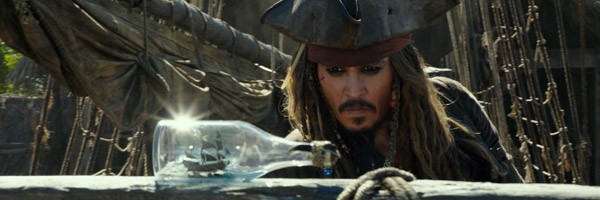
Pirates: Fact vs. Fiction

The highly anticipated Pirates of the Caribbean: Dead Men Tell No Tales hits theaters this weekend! Our beloved Captain Jack Sparrow goes on another swashbuckling adventure after being down on his luck.
Pirates are fascinating to so many of us, but there’s so much more to their history than we realize. Nicole Castroman, author of YA adventure romance Blackhearts and its recently released follow up, Blacksouls (the re-imagined tale of notorious pirate Blackbeard), gives us the scoop on what’s real and not real when it comes to pirates!
Pirates: Fact vs. Fiction
Childhood stories and blockbuster movies about pirates portray a desire for adventure, danger, and thrills, because those tales touch something deep inside of us. They speak to our souls, longing for the open water and freedom. Pirates were considered anarchists who lived life by their own rules and supposedly spoke in colorful language and dressed in colorful attire. No other profession in history has been idealized and romanticized as much.
There’s something about standing on the rolling deck of a ship with no land in sight, the sun shimmering on the white-tipped waves and the briny air filling your lungs. Sailing is like a conversation where communication is physical. Popular culture would have us believe that the life of a pirate during the Golden Age of Piracy was all about living fast and dying young.
But the truth is, what we imagine pirates to look and sound like matches only one decade of history: 1716 to 1726. Prior to that, pirates were often accepted members of their communities. Many of them married and settled down. Most individuals who turned to piracy hoped to capture one large prize and use their plunder to join the upper echelons of society, because life at sea was unpredictable and dangerous. There could be long periods of inactivity and boredom on pirate ships before a sail was spotted or a storm appeared on the horizon.
In most cases piracy was only an act or a phase, not a way of life. Seamen lived in cramped and filthy quarters. Rats gnawed through anything, including a ship’s hull. Food spoiled or became infested and water turned foul. And sailors fell victim to any number of diseases. Not exactly prime conditions to work under, which is why the majority of pirates were probably in their ’20s, with some exceptions.
Blackbeard was one of those exceptions, a legend in his own time. His reign of terror lasted only two years, but he was close to forty when he died in battle near Ocracoke, NC on November 22, 1718. He was aggressive as well as decisive. Nobody knows what Edward Teach did as a young man or what led him to become one of the most notorious and dreaded pirates to sail the seas. Yet despite his fearsome reputation, there is no record of him ever killing anyone before the last battle that eventually took his life. He was truly a strong and charismatic individual.
Living under such dangerous conditions, one might question why anyone would turn to piracy. The oceans were and always will remain untamed. The seas can take a violent swipe at anyone who chooses to cross them. Before the days of GPS and diesel engines, why would someone risk his life repeatedly if there was no chance he could spend his plunder. For many, piracy offered them a choice between starvation, beggaring, or thievery and possible riches beyond their wildest dreams. It was a crime of opportunity. Some chose this activity because they found themselves in areas where law enforcement was at a minimum or practically nonexistent, and the possibilities of success outweighed the threat of execution if caught and a short life-expectancy rate.
Many pirates were honest sailors who abandoned their jobs because the conditions on merchant or navy ships were so awful. A good portion of the British Navy consisted of men forcibly recruited by hired thugs who combed the harbors, looking for anyone with a full set of limbs. “Pressed men” were paid less than volunteers, if they were paid at all. They were shackled to the ships while in port so they didn’t try to escape and were flogged for any minor offense. Some pirates were forced to join pirate ships, especially if they had highly sought after skills, such as surgeons. Only a small minority of men became a pirate because they actually enjoyed being a criminal.
There were female pirates as well. At a time when women couldn’t even get a job or an education, one of history’s most influential raiders began her career in a Chinese brothel. Cheng I Sao, was a Cantonese former prostitute who married a powerful corsair named Cheng I in 1801. Together, they raised one of China’s most formidable pirate armies. After her husband’s death, she continued to lead up to 80,000 men, preying on the fishing vessels, supply junks and the coastal villages of Southern China. The government was so desperate for her to quit, they offered her immunity if she would give up her pirating ways. She retired, a wealthy woman and lived out the rest of her days in peace.
Anne Bonny was the illegitimate daughter of a wealthy Irish lawyer. Her father had her dress as a boy and pose as his law clerk for part of her youth. She later moved to America, where she married a sailor and journeyed to the pirate-infested island of New Providence in the Bahamas. There, she fell in love with “Calico” Jack Rackam, a flamboyant buccaneer who sailed the Caribbean. Abandoning her husband, she joined Rackam’s crew. Bonny had a fierce and courageous temper and almost beat a man to death when he tried to force himself on her.
She later forged a friendship with fellow female pirate Mary Read, who had spent most of her youth disguised as her deceased half-brother. Mary adopted the name Mark Read and took on a succession of traditionally male jobs, first as a soldier and later as a merchant sailor. Read turned pirate in the late-1710s, when buccaneers attacked the ship she was working. She eventually joined Rackam’s crew. When Calico Jack’s ship was captured by a band of pirate-hunters. Bonny and Read dodged the noose after they were both found to be pregnant. Rackham and several other pirates weren’t so lucky and were hanged.
The more familiar pirates were with an area, the better their chances were at finding prey. If too much time passed in between raids, their supplies could become dangerously low. A merchant ship filled with gold wasn’t always the most valuable plunder. Often times, pirates simply needed to replenish their stores in order to move on. Unlike most ships, pirates couldn’t simply pull into a port and restock their provisions, and so they stole whatever they could when they stopped another vessel.
When pirates did encounter a merchant ship they wanted to pillage, they didn’t immediately attack. First, they had to determine if the ship rode high or low in the water. (Empty cargo vs. a full load) They also had to ascertain a ship’s firepower. This could take several hours to several days. Once they decided to attack, the pirates fired a warning shot to scare their target into submission. More often than not, merchant crews weren’t paid enough to put up much of a fight, and they were often given the opportunity to join the pirates.
If a pirate ship was lucky enough to capture another vessel, it was time to head to port. Author Robert Louis Stevenson’s 1883 novel “Treasure Island” popularized the concept of buried treasure, another common pirate myth. Contrary to popular belief, pirates did not use a hole in the ground as their savings account. They were more likely to squander their spoils on women, rum and gambling as soon as they returned to land.
Pirates were notorious for their lawlessness and brutality. Yet they incorporated principles of democracy and adhered to the ideals of liberty, equality and brotherhood. The crews elected their captains, and signed articles of agreement to ensure that everyone earned a share of any prize taken. Such freedom was unavailable to men who remained on the right side of the law. If anyone was wounded during a battle or in the line of duty, pirates received the equivalent of workers’ comp. The worse the injury, the more money they could expect.
Contrary to another popular belief, pirates didn’t use eye patches to mask an empty eye socket. Instead, they wore eye patches so that one eye would remain constantly adjusted to the dark, which made it easier to fight below deck when boarding ships. The modern U.S. military uses similar tactics for nighttime engagements.
There are also reports of people forced to walk the plank. In truth, it was an extremely rare form of punishment. ‘Keelhauling’ was much more common. The rule-breaker would be tied to a rope and hauled under the keel of the ship and back up until he either drowned or was cut to shreds by barnacles. Marooning was also popular, but unlike Jonny Depp’s character in Pirates of the Caribbean, most people died when left alone on a deserted island. Without food or water, they were promised a slow, cruel death without hope or reprieve.
Historically, pirates have always been a fascinating subject. With tales of adventure, danger and daring, it’s easy for us to romanticize a life seemingly without rules. Even Mark Twain entertained thoughts of piracy, as he wrote in Life on the Mississippi, “Now and then we had a hope that if we lived and were good, God would permit us to be pirates.” With the upcoming release of the fifth installment of the Pirates of the Caribbean franchise, Dead Men Tell No Tales, I don’t anticipate this fascination dying off anytime soon.
![]()
Check your local theaters to see Pirates of the Caribbean: Dead Men Tell No Tales, and click below to order Nicole Castroman’s addictive and fascinating novels!
Series reading order
Follow Nicole
✦ ✦ ✦ ✦ ✦ ✦ ✦ ✦

Subscribe for Updates:







 by
by
Jessica Lawson said:
What a great post! I’ve done some pirate research for a character and Anne Bonny was one of my favorites to learn about.